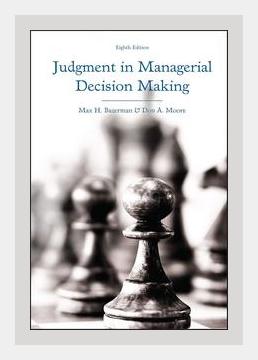Leadership and ManagementDecision Making
Title: Judgment in Managerial Decision Making
Authors: Max H. Bazerman, Don A. Moore
Year: 1986
Summary
I. Introduction to Decision Making
Overview
– The book provides a comprehensive insight into how managerial decisions are made and the common biases and errors that affect judgment. It emphasizes the importance of understanding these pitfalls to improve decision-making processes.
Concrete Example
– A manager consistently chooses to promote employees based on intuition rather than performance metrics, leading to higher turnover and reduced productivity.
Action Point
– Implement structured performance evaluations to guide promotion decisions based on quantifiable metrics rather than gut feeling.
II. The Role of Bias in Decision Making
Overview
– Bazerman and Moore highlight various cognitive biases that influence managers’ decisions, such as overconfidence, anchoring, and confirmation bias.
Concrete Example
– Overconfidence Bias: A CEO predicts a 15% growth in the next quarter based on past performance without considering market changes, resulting in missed opportunities and misallocation of resources.
Action Point
– Conduct periodic reality checks by comparing predictions with actual outcomes and adjusting forecasts based on a broader range of data.
III. Anchoring Effect
Overview
– Decision-makers often rely too heavily on the first piece of information offered (the “anchor”) when making decisions.
Concrete Example
– In salary negotiations, the initial salary offered becomes an anchor, influencing the final agreed-upon salary regardless of actual job worth or industry standards.
Action Point
– Gather comprehensive market data and set a pre-defined salary range before entering negotiations to ensure decisions are based on objective criteria rather than initial offers.
IV. The Availability Heuristic
Overview
– Managers tend to give excessive weight to information that is most readily available, often due to recent experiences or salient examples.
Concrete Example
– A manager recalls a recent project failure and becomes overly conservative in approving new projects, ignoring statistical success rates.
Action Point
– Maintain a balanced perspective by periodically reviewing historical data and considering a broader timeframe to base decisions on well-rounded information.
V. Confirmation Bias
Overview
– Managers often seek out information that confirms their existing beliefs and ignore or undervalue information that contradicts them.
Concrete Example
– An executive feels loyal to a long-term supplier and dismisses competitive bids offering better terms, resulting in unnecessary cost overruns.
Action Point
– Promote a culture of critical thinking by inviting diverse viewpoints and systematically reviewing contrary evidence before finalizing decisions.
VI. Escalation of Commitment
Overview
– The tendency to continue investing in a failing project due to the amount already invested, rather than cutting losses.
Concrete Example
– Continuing to fund an underperforming marketing campaign because significant money has already been spent, instead of reallocating to more promising alternatives.
Action Point
– Establish clear criteria for project continuation or termination, and regularly review projects against these benchmarks to prevent sunk cost fallacies.
VII. Ethical Considerations in Decision Making
Overview
– Ethics play a crucial role in decision-making. The authors emphasize the importance of ethical behavior and transparency in fostering trust and long-term success.
Concrete Example
– A manager decides to overlook a minor safety violation to meet a project deadline, compromising worker safety and potentially facing regulatory action.
Action Point
– Develop and strictly adhere to a code of ethics and set up regular ethics training programs to ensure all decisions prioritize integrity and compliance.
VIII. Group Decision Making and Pitfalls
Overview
– Group dynamics can significantly affect decision-making quality. Problems like groupthink can stifle innovation and lead to poor outcomes.
Concrete Example
– A product development team dismisses alternative ideas too quickly due to a dominant team leader’s influence, resulting in a less-competitive product.
Action Point
– Foster an inclusive environment by encouraging all team members to voice their opinions and implementing structured decision-making processes like nominal group technique.
IX. Improving Decision Making Skills
Overview
– The book outlines various strategies to enhance decision-making skills, including training, feedback loops, and analytical tools.
Concrete Example
– A company implements a decision-making workshop focusing on recognizing and mitigating biases, leading to more balanced and effective managerial decisions.
Action Point
– Invest in continuous professional development programs focusing on critical thinking, bias recognition, and evidence-based decision-making.
X. The Importance of Decision Traps and How to Avoid Them
Overview
– Recognizing and avoiding decision traps such as framing effects, overconfidence, and sunk costs is crucial for effective management.
Concrete Example
– A manager frames a decision to invest in new technology as a choice between modernizing (positive frame) and falling behind (negative frame), influencing team opinion subconsciously.
Action Point
– Use neutral language in presenting choices and actively seek third-party reviews to help identify and mitigate potential decision traps.
Conclusion
Final Thoughts
– The insights from Bazerman and Moore’s “Judgment in Managerial Decision Making” are invaluable for managers seeking to refine their decision-making approaches. By understanding and mitigating common biases and fostering an environment of continuous learning and ethical behavior, managers can make more informed, balanced, and effective decisions, ultimately enhancing organizational success.
By integrating these practices into everyday managerial routines, individuals can significantly improve their decision-making abilities, fostering more robust, innovative, and ethical organizational cultures.
